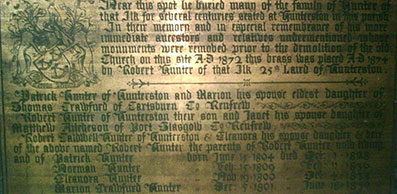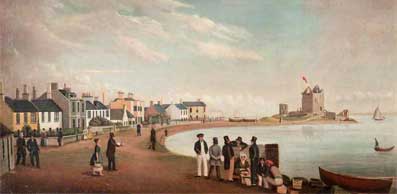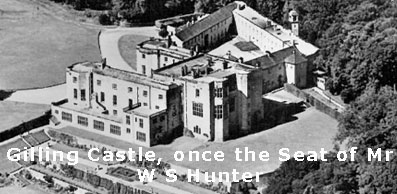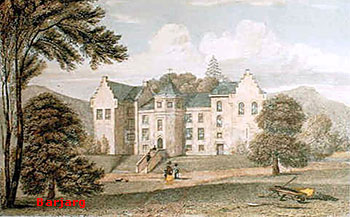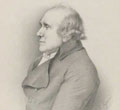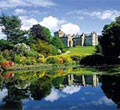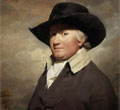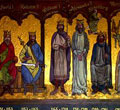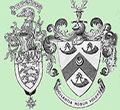History of Hunter
part four
He was succeeded by his eldest son, Robert Hunter of Hunterston, or of that Ilk, who is designed "younger of Hunterston" in the "Roole of the Remonstrators," 1650, as well as in a charter dated 19th November, 1658, by Richard, Lord Protector of the Commonwealth of England, in favour of himself and of the heirs of his marriage with his late wife Elizabeth, (daughter of Patrick Craufurd of Auchinames, by his cousin and wife, Jean Crawfurd of Corsbie,) in the lands of Hunterston.
He married, secondly, Marion, eldest daughter of James Cuninghame of Aiket (a descendant of the house of Glencairn), by Euphan, daughter of the Rev. William Russell, minister of Kilbride, as appears by a precept of sasine following the above charter, of the 7th December, 1658. He, with Marion Cuninghame, was infeft, as heir of his father, in Hielies, in 1669; and his last deed is dated in June, 1674.
By his second marriage he had no issue: by his first he had four sons and one daughter, viz. :
1. Patrick, his heir.
2. Robert Hunter, A.M., (1643) of Glasgow University, minister of Kilbride, ancestor of the Hunters of Kirkland.
3. James, bred to the bar, who married Margaret Spalding, sister to the Rev. John Spalding, minister at Dreghorn, by whom he had General Robert Hunter, who died Governor of Jamaica in 1734. He married Lady Mary Dalziel, only child of James, fourth Earl of Carnwarth, and widow of John, Lord Hay, colonel of the Scots Greys, second son of John, second Marquis of Tweeddale. His descendants are the Orby Hunters of Croyland Abbey, Lincolnshire.
4. Hugh, who was a physician in Kilmarnock.
5. Jean, who married Rev. John Spalding, minister of Dreghorn.
Robert died in December, 1679, and was succeeded by his eldest son Patrick.
Patrick Hunter of Hunterston, or of that Ilk, whose retour is dated 19th January, 1680, and who married Marion, daughter of John Cuninghame of Laugmuir (whose son Alexander is styled of Kerrie Lamont, in the Isle of Bute), by Dorothea Cuninghame, his wife, during the lifetime of his father and of his grandfather, in 1662. By this marriage he acquired the lands of Langmuir.
His title to his estate was ratified by King William III. and the estates of Parliament, on the 27th June, 1698, " in consideration of good and faithful services done and performed to his Majesty and his royal progenitors."
He died towards the end of 1699, leaving the following issue :
1. Patrick, who succeeded.
2. Henry, who was ordained minister of Mearns in 1713, and died in 1733.
3. John.
4. Dorothea, married to Henry Cuninghame of Carlung, and had a numerous issue.
5. Marian, married in 1694 to John Peebles of Crawfield, without issue.
6. Anna, married in 1702 to Alexander Cuninhame of Clogher, county Tyrone,
7. Margaret.
He was succeeded by his eldest son,
Patrick Hunter of Hunterston, or of that Ilk, who having, at a meeting of gentlemen at Largs on the 1st July, 1689, acknowledged a leaning towards King James VII., would have been treated as a rebel but for the timely interference of Crawfurd of Kilbirny, who broke his sword and privately wrote to his father, the Laird of Hunterston as follows :
Kelsoland, 2d July, 1689.
Sir, The kindness I have for you and your family forced me to inform you, with very much trouble, that your son had the misfortune yesterday to own King James's interest, and to quarrel with the gentlemen who were witnesses to it, who urge me mightily to acquaint the publick with it, which I must do for my own safety, if you get it not prevented, being engaged in the service of the jurisdictione ; and therefore my best advice to you is, that you would come to the Largs about four o'clock in the afternoon, and to try if you can prevail with the gentlemen that your son be not represented, in which I will do your son all the kindness I can, as I did yesterday, though I was forced to break his sword to prevent his greater danger.
Let none know that I have given you this advertisement.
I am,
Sir, Your humble servt.,
Kilbirny.
He married Marion, eldest daughter of Thomas Crawfurd of Crawfurdsburn, or Cartsburn, on the 5th May, 1704. Hospitable and extravagant, it was not until he had alienated a considerable portion of the estates of the family that he was induced by Lord Glasgow to execute a conveyance of his rents of Hunterston to his eldest son, Patrick,
"out of the sincere regard he had for the preservation of his family, with power to him to uplift and employ the samen for the best uses of mentaining and preservation of the memory of the family reserving to himself to be mentained in the house Hunterstoun in bed, board and washing, as the circumstances will allow."
This curious document is written by David Earl of Glasgow, and subscribed at Kelburn House on the 3d January 1729.
He died on 9th November, 1738 having had issue by Marion Crawfurd, his wife, five sons and five daughter -
1. Patrick, who predeceased his father in 1732, unmarried.
2. Robert, who succeeded.
3. Thomas.
4. Henry.
5. David, who married Miss Milliken of Port Glasgow, by whom he had Patrick Hunter, merchant in London, from whom is descended Captain Charles Fleming Hunter, 72d Highlanders, Captain Hunter served in the Crimea from June, 1855, including the expedition to Kertch, siege and fall of Sebastopol, and attack of the 18th June. Served through the operations in Central India, and pursuit of the rebel forces under Tantia Topee and Eao Sahib, in 1858-59.
6. Rebecca, who died unmarried.
7. Elizabeth, married to John Hyndman of Lunderston.
8. Marion, married to Hugh Muir.
9. Dorothea, married, firstly, to William Kelso of Hullerhirst, and, secondly, to Hugh Weir of Kirkhall.
10. Margaret, married to Robert Caldwell, descended from a family which settled in the neighborhood of Larne, county Antrim, during the religious persecutions which raged in Scotland towards the close of the seventeenth century. By her he had, in 1763, a son, Robert, of whom presently.
The Laird of Hunterston was succeeded by his eldest surviving son,
Robert Hunter of Hunterston, or of that Ilk, who married. in 1762, Janet, daughter of Matthew Aitcheson, by Eleonora daughter of John M'Gilchrist of Easter Porsill. Mrs Hunter died in 1787, but her husband survived her some years, dying in 1796, at the patriarchal age of 86.
He is thus described by Mr John Fullarton of Overtoun, West Kilbride, in a recent interesting work from his prolific pen : -
"Mr Hunter succeeded to the estate in a deeply encumbered condition, at a period too, perhaps, the most depressed and embarrassed which has ever occurred in Scottish affairs; but long ere the close of his life, by singular prudence and economy, he was enabled not only to clear off all encumbrances, but likewise to leave his successors in comparative wealth and independence; and thus be might well be viewed as a second founder of his ancient family."
The writer of this brief and imperfect notice, though having been but once, and that at a very early period of life, in the company of this venerable and worthy man, yet the impression of his appearance and manner has hardly in any degree yet faded from memory.
"He was quite a tall man... yet still pretty erect in gait and movements." Scott's vivid delineation of the Baron of Bradwardine would have been quite applicable to 'Hunterston' at a similar period of life, as doubtless there were other and more important points of agreeance between the individuals. Throughout life Mr Hunter had certainly been of a spare and active habit of body. His visage was long, the forehead being high and narrow, with singularly hollow temples. His hair was of a sandy fair colour, still pretty full, and perfectly free from greyness. In every feeling and habit of mind, the Laird of Hunterston appears to have been a true Scottish baron of the genuine age of baronage. . . The, as it were, hereditary tenants of his property he would in no wise displace from their original possessions, frequently remarking that most of them, if not all, had held their occupancies from as early a period as he did himself...... In politics, as in all else, the baron of Hunterston was unalterably Conservative, or perhaps more properly, Whiggo-Conservative, in the true and legitimate sense of the term; and of course his sympathy and affection were altogether sincerely and honestly in favour of the unfortunate family of Stuart. But he was far too sensible and prudent a man for a moment to conceive it possible that their ideas of religion and government could ever again be tolerated in this country. This venerable and worthy man, the last of his class of Scottish society in this locality a class perhaps now wholly extinct died, as before stated, in the spring of 1776,"
having had issue by Janet Aitcheson, his wife :
1. Thomas Orby, died young
2. Patrick John, died young
3. Eleonora born 22d October, 1764 who succeeded.
4. Marion.
5. Elizabeth.
Eleonora Hunter heiress of Hunterston, was served as heiress in general to her father on 28th April, 1796, and in the May following, married her cousin, Robert Caldwell above-named, who assumed the name of Hunter in addition to his own.
He built the present mansion-house of Hunterston, and greatly improved the estate. He died on the 22d August, 1826, and his wife on 24th December, 1851.
Their family consisted of
1. Robert, who succeeded.
2. Patrick, died in 1826.
3. Norman, died in 1836.
4. Eleonara, died in 1833.
5. Marion Crawfurd, died in 1830.
6. Margaret.
7. Janet.
Robert Hunter of Hunterston, or of that Ilk, the present proprietor of Hunterston, and the representative of that ancient house, is a Justice of the Peace and a Deputy-Lieutenant of the county of Ayr. He married on the 23d day of November, 1836, Christian Macknight, eldest daughter of William Macknight Craufurd of Cartsburn, (cadet of Jordanhill, and descended from the distinguished family of Kilbirnie), by Jane, second daughter of John Crawford of Broadfield, county of Renfrew,
by whom he had two daughters:
1. Jane, married, 8th July, 1863, to Lieut-Colonel Gould Weston, of a family of that name settled for several generations in Dorsetshire (Lane House, now in the possession of W. H. P. Weston of Wolverton, having been acquired by Henry Weston, the great-great-great grandfather of Lieut. -Colonel Weston, in 1699) but whose ancestors were seated at Weston-under-Lizard, county of Stafford, in the reign of Henry II.
The issue of this marriage is Aylmer Gould, born 23d September 1864,
2. Eleonora.
Arms. It appears from the records of the Lyon offices that the ancient bearings of this family, as undermentioned, were varied at comparatively modern dates; for at and prior to the commencement of the seventeeth century they were emblazoned vert; three dogs of chase, arjent ; on a chief of the second, three hunting horns of the first, bandressit, gules; and were thus borne until a recent period ; when, on petition, the Lord Lyon " ratified, maintained, and confirmed" the original arms of Hunter, "Praefectus venatorum regiorum in Cuninghame," and caused due record to be made in the Register of Arms of the following ensigns armorial :
Arms. Or. three hunting horns, vert, garnished and stringed, gules.
Crest. A greyhound sejant proper, gorged with an antique crown, or.
Supporters. Two greyhounds proper, gorged with antique crowns, or.
Motto. " Cursum Perficio."
Note. We are indebted to Mr Hunter of Hunterston, not only for the ready access which he has afforded to the ancient and valuable records contained in his ample charter chest, but for the references and materials which he has supplied for the subjoined outline of the services of his son-in-law, Lieut.- Colonel Weston.
Lieut. -Colonel Weston, after completing his education at the Military College of Addiscombe, entered the Indian army in 1840, and for the greater portion of his service was attached to the staff of the Bengal Presidency. He was for some years on diplomatic employ at the court of Oude, under Sir William Sleeman and Sir James Outram, and from 1849, to the mutiny of the native army in 1857, was in sole charge of the operations for the extirpation of the atrocious bands of Thugs (professional stranglers and poisoners) and Decoits (gang robbers) which infested that kingdom.
He repeatedly received the thanks of his official superiors for the success which attended his exertions; and Sir William Sleeman, in his report on the state of crime in Oude, records that there were "not one-tenth of the noted freebooters at large and at work in Oude that existed when Captain Weston first took charge of his office in 1849, and that this diminution was mainly owing to the ability and energy displayed by him."
He was in political charge, and vested with special powers, at the capture of the Durriabad forts in Oude, in March and April, 1850, for which he received the thanks of Government, and was appointed an assistant to the Resident at Lucknow; and his services in the diplomatic department gained, amongst other abundant testimony, most flattering acknowledgment in Sir William Sleeman's despatch to the Governor- General of India, Lord Dalhousie, and in the special report made by the Resident at the court of Oude to the Governor-General, dated 11th September, 1854.
In 1854 Captain Weston rejoined his regiment, under orders for service in Pegu, and was employed for some months on detached command on the extreme northern frontier of that province, to the eastward of the Irrawaddy, which had been devastated, and was overrun by predatory bands of Burmese, whose incursions across the border were incessant.
The sickness and mortality amongst the men and horses of Captain Weston's detachment of infantry and irregular cavalry, exposed to constant duty amidst the pestilential exhalations of these forests and jungles during the whole of the rainy season, was unusually severe; and but few lived to leave Pegu eventually on the relief of the regiment.
Towards the close of that year, however, Captain Weston was recalled to India to resume his duties on the Political Staff, and in that capacity was present at the memorable interview between the last King of Oude and the British Resident, so graphically described by Kaye, when, on the 4th February, 1856, Outram announced to Wajid Ullee Shah that his kingdom had passed from him.
On the annexation of Oude, in 1856, he was appointed to the organization and command of the Military Police, a force armed and modeled on the system of the Irish Constabulary, and consisting of 1000 Cavalry and three regiments of Infantry, under the command of European officers, and which performed good service in the newly acquired province until the commencement of the Indian mutiny.
"We learn from Captain Hutchinson's narrative that, at the outbreak of the insurrection in 1857, Captain Weston was detached by Sir Henry Lawrence to Mullebad, for the purpose of restoring confidence and order to that district then in open armed revolt. "His escort consisted of one company of that 7th Regiment so lately in mutiny at Moosa Bagh, and some Mounted Police;" and Captain Hutchinson adds, that "nothing but the bold determined firmness of Captain Weston overawed the 3000 fanatic wretches who surrounded him."
"Captain Weston's Daring Act," on the occasion of the mutiny of the Military Police is recorded at length by Rees in his vivid history of the siege of Lucknow, and its details afford abundant proof of the respect and affection with which this officer inspired his men even at a time when they showed themselves ingrates and rebels, and were in the act of throwing off the authority which they had hitherto acknowledged. "Prior to the commencement of the siege of the Lucknow Residency, Captain Weston was appointed by Sir Henry Lawrence to the command of an outpost, which he held without a day's intermission from the 30th June to the evacuation of the garrison on 22d November, 1857.
The fire to which the British force was exposed may be estimated from the fact that the strength of this outpost was kept up to forty-five of all ranks, vacancies being supplied from the reserve, and that its total loss during the siege amounted to fifteen killed, and thirty wounded, that is, by a remarkable coincidence, tantamount to the original strength of the outpost.
On the evacuation of the Residency of Lucknow, Captain Weston volunteered, and was one of the few officers of the "Old Garrison" who remained at Alum Bagh. He was appointed to the Staff of Major-General Sir James Outram in command of the force before Lucknow, and was made Chief of the Intelligence Department.
He was present at the whole of the engagements at Alum Bagh, where for many weeks Outram with his little force kept at bay the vast army of mutineers and rebels assembled at and around the capital, and he was engaged throughout the subsequent operations on the final advance of the array under the Commander-in-Chief, leading to the capture of Lucknow on the 16th March, 1858.
His name having been inadvertently omitted in the celebrated despatch of Sir John Inglis of the 26th September, 1857, the erratum was brought by Sir John Inglis to the notice of Grovernment, and was rectified in General Orders No. 1546 of 1858; and in the "Roll of Officers deemed deserving of honourable mention," which was attached to Sir James Outram's despatch to the Commander-in-Chief, relative to the capture of Lucknow, the Major-General records that Captain Weston "displayed much spirit and gallantry on several occasions, and his services were of much use to me."
The subjoined letter was addressed to Captain Weston by "the Bayard of the Indian Army" on his giving up the command of his Division, on the re-occupation of Lucknow, and is dated:
Lucknow, 2nd April, 1858.
My Dear Weston, I cannot leave without writing a few lines to tell you how grateful I am to you for the zealous, able and valuable services you have rendered me, both at Alum Bagh and since the re-occupation of the city, as well as during our late military operations. I sincerely trust that you will continue to enjoy many opportunities of distinction, and I feel assured that opportunity is all you require.
God bless you my dear Weston.
Yours very sincerely, (Signed) J. Outram.
To Captain Weston, etc., etc., etc.
Published in Government Gazette of 15th November, 1857.
He received his Brevet majority for the "Defence of Lucknow," and has a medal and two clasps.

